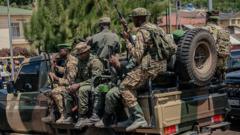Did Trump Greenlight Attack Plans for Iran Without Making a Final Decision?

Understanding the Current Tensions Between the U.S. and Iran
The geopolitical landscape surrounding U.S.-Iran relations has reached a boiling point, marked by threats, military build-ups, and intense diplomatic exchanges. Recent developments, particularly involving U.S. President Donald Trump and Iran’s Supreme Leader Ayatollah Ali Khamenei, have escalated concerns about potential conflict. This article delves into the intricate dynamics at play and what they mean for international security and the future of U.S.-Iran relations.
Background of U.S.-Iran Relations
To comprehend the current situation, it's essential to look at the historical context of U.S.-Iran relations. Following the 1979 Iranian Revolution, the relationship soured dramatically. The U.S. imposed sanctions, which have persisted over the decades, particularly after Iran's nuclear program became a focal point of international concern. This complicated history sets the stage for the recent military and diplomatic maneuvers.
The Nuclear Issue and Its Consequences
At the heart of the tensions is Iran’s nuclear program. The U.S. and its allies fear that Iran’s pursuit of nuclear capabilities could lead to the development of nuclear weapons, destabilizing the region. In response, various sanctions and diplomatic efforts, including the Joint Comprehensive Plan of Action (JCPOA) in 2015, were implemented to limit Iran’s nuclear activities. However, the U.S. withdrawal from the JCPOA in 2018 under Trump's administration led to a significant escalation in tensions.
Recent Developments: Military Options on the Table
Recently, reports have surfaced indicating that President Trump has approved plans to potentially strike Iran's underground uranium enrichment facility at Fordo. This decision comes amidst ongoing military buildups in the Middle East, with the U.S. deploying additional naval forces, including the USS Nimitz and USS Carl Vinson strike groups. The potential for military action is underscored by statements from Trump's defense officials, indicating readiness to execute orders if necessary.
The Role of Israel in the Conflict
Israel has also intensified its military operations against Iran, targeting missile sites and nuclear facilities. Israeli Prime Minister Benjamin Netanyahu has publicly stated that his forces are "progressing step by step" towards neutralizing threats posed by Iran's nuclear ambitions. The Israeli military actions have further complicated the already volatile situation, prompting retaliatory measures from Iran.
- Israeli attacks have reportedly resulted in significant casualties among Iranian forces.
- Iran's response has included missile strikes aimed at Israel, leading to civilian casualties.
Diplomatic Stalemate and War of Words
Recent exchanges between Trump and Khamenei highlight the deepening rift in diplomatic relations. Khamenei has outright rejected Trump’s demands for unconditional surrender, asserting that Iran will not yield to what he terms "duress." Trump's dismissive response—“good luck”—reflects a lack of interest in diplomatic negotiations at this juncture, further exacerbating the situation.
The Impact on Civilians
As military actions escalate, the impact on civilians is becoming increasingly severe. Reports from various human rights organizations indicate a rising death toll, including numerous civilian casualties in both Iran and Israel. The ongoing conflict has led to mass evacuations, particularly among American citizens in Israel, as tensions heighten.
The Role of International Actors
International reactions to the unfolding crisis are varied, with allies and adversaries closely monitoring the situation. The U.S. has not formally requested support from its allies, such as the UK, to conduct potential military operations from bases in the region. This lack of coordination raises concerns about the broader implications for international security and the potential for expanded conflict.
Potential Outcomes and Their Implications
As tensions mount, several scenarios could unfold:
- Military Escalation: A U.S. strike on Iranian facilities could lead to a broader conflict, drawing in regional allies and potentially resulting in widespread violence.
- Continued Diplomatic Stalemate: If no diplomatic solutions are reached, the cycle of attacks and retaliations may persist, further destabilizing the region.
- Negotiated Settlement: Despite the current rhetoric, there is always the possibility of back-channel negotiations leading to a de-escalation of tensions, though this appears unlikely in the short term.
The Humanitarian Crisis: A Call to Action
The ongoing conflict has dire humanitarian implications. As military strikes continue, the situation for civilians in both Iran and Israel deteriorates. Humanitarian organizations urge for immediate measures to ensure the safety of civilians and access to essential services. The international community must step up to mediate and seek peaceful resolutions to avert further loss of life.
FAQs
What are the main reasons for the current tensions between the U.S. and Iran?
The tensions primarily stem from Iran's nuclear program, the U.S. withdrawal from the JCPOA, and ongoing military actions by both the U.S. and Israel against Iranian targets.
How has Israel been involved in the conflict with Iran?
Israel has conducted military operations targeting Iranian missile sites and nuclear facilities, which it views as direct threats to its national security.
What might happen if the U.S. decides to strike Iran?
A U.S. strike could lead to a significant military escalation, resulting in broader conflict and potentially drawing in regional actors, exacerbating the humanitarian crisis.
How are civilians affected by the ongoing conflict?
Civilians are facing increased risks of casualties, displacement, and disruption of essential services as military actions intensify.
Conclusion: The Path Forward
The current trajectory of U.S.-Iran relations is precarious, with the potential for military engagement looming large. As diplomatic channels remain largely unutilized, the situation demands urgent attention. The international community must prioritize peaceful negotiations to avert a humanitarian disaster and work towards a lasting resolution that addresses the underlying issues of security and sovereignty. In a world that thrives on dialogue, can we afford to let tensions spiral further out of control?
#USIranRelations #MiddleEastConflict #PeaceNegotiations
Published: 2025-06-19 03:12:03 | Category: technology



